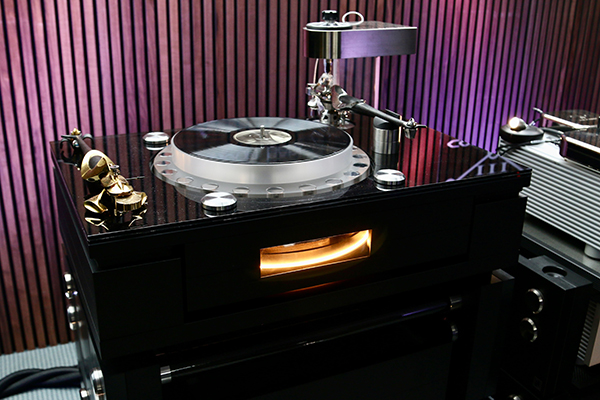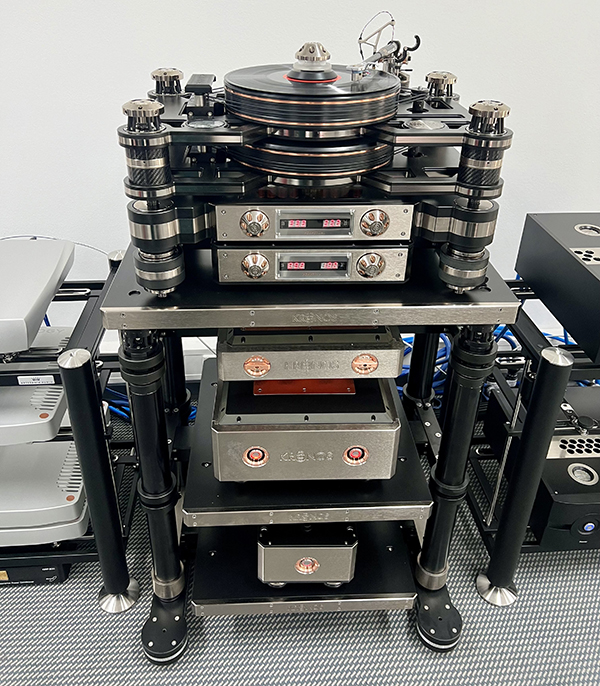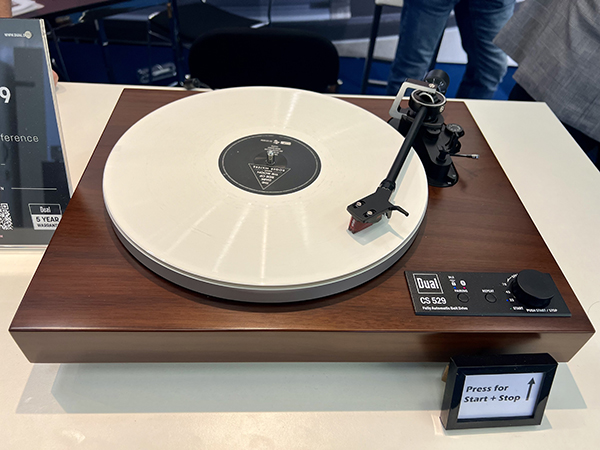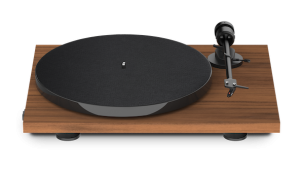High End Munich 2024 Postscript, Part 1: New Gear From Wilson Benesch, Rui Borges, Kronos Audio, Dual, and Silence

This week, I’ll be wrapping up my Munich 2024 show coverage in two parts. As you’ll recall, the High End Munich Show was held once again at the MOC, a.k.a. the Event Center Messe München, from May 9-12, 2024. This year, the show garnered the highest level of attendance with more than 22,000 visitors over the show’s 4 days, in addition to having the highest number of exhibitors — approximately 520 — in its history.
Munich 2024 featured many new turntable designs, ranging from the very affordable to the extreme and extravagant. To commence the first of two Munich 2024 postscript show reports, what follows is an example of a turntable designed from top to bottom where it seemed like the sky was the limit as to what was possible.

WILSON BENESCH
Hi-fi manufacturer Wilson Benesch of Sheffield, England, debuted an exciting new turntable system, the Reference GMT One, which includes a Graviton tonearm, Tesselate cartridge, and R1 rack system. The Wilson Benesch Prime Meridian turntable was the model in the active system, as seen above. (The arm and carts each come in multiple variants; all are sold separately.) The company designed, developed, and made these components to be used within a complete system.
In sum, all parts are precision- and purpose-engineered to the max. To develop these products, the manufacturer consulted with an engineering firm that works across industries to solve engineering problems, sometimes in novel ways. Biomimicry is one thematic element. At least four engineers reportedly were involved in the Graviton tonearm design alone.

Wilson Benesch was a pioneer of carbon fiber use for tonearms as early as 1990, Marketing Manager Luke Milnes told me. He explained more about its design of the various elements, of which I’ll hit on the key points.
The Graviton tonearm’s arm wand is made of two sheets of carbon fiber wound together opposite to one another in a helix form — like a tree growing, it becomes stiffer in all directions, Milnes said. The helix form also creates a series of boundaries to absorb the energy for resonance damping throughout its length. The metal top part is made of titanium: a beam of laser light is used melt and build it up together layer by layer, welding it to create a tessellated structure that resembles a honeycomb. “We’re using this tessellation here to 1) reduce the mass of the structure, and 2) because tessellated structures have more stiffness, they function like an exoskeleton,” Milnes explained.

The base is solid titanium for stability and a lower center of gravity. The kidney-shaped counterweights have titanium powder left inside them — akin to sandbags — to minimize resonances. All the usual adjustments are possible, and Wilson Benesch claims the vertical tracking angle (VTA), which is adjustable via remote control or mobile app, is accurate to a nanometer — the equivalent to 1/10 of a human hair, Milnes said.

The GMT system’s Prime Meridian table features a unique, 15in low-torque, low-power motor that has a magnetic field moving across it horizontally. “The air gap is quite large,” Milnes continued. “What that allows us to do is create a very even distribution of fields across all the coils [21 copper coils surround the motor]. This means you get zero cogging within the design. It’s smooth and fluid.”

The GMT system’s Omega drive also has a patented bearing. The shaft is made of tungsten carbide, second only to diamond in material hardness, added Milnes. But a shaft sees wearnes over time. To solve this concern, magnets are used once again — to act as a sort of counterbalance. “We actually have magnets that oppose the weight of the platter and the bearing, so you have just enough weight to get the drive,” Milnes explained. “But we have some very clever people at Sheffield University who calculated exactly how much magnetic force would be needed to oppose that. So, you have just enough to get your movement, but nothing more so you don’t wear out the bearing.”
Concluded Milnes, “If you see anything like this again, it would be because we’ve licensed it to another company.” Regrettably, I didn’t have enough time to listen to the GMT One system for all that long, but what I did hear sounded incredibly smooth, and all of it seemed vivid and intensely — but not artificially — real: intense tonal colors, timbres, and leading-edge transients in the music were all noticeable.

RUI BORGES
Portuguese maker Rui Borges presented their new Pendulum II turntable outfitted with a Supreme Analog Tangenta tonearm from Serbian designer Zoran Mihajlovic. The Tangenta arm contained Cardas cabling inside and ended with a Clearaudio Goldfinger Statement cartridge, the German analog maker’s top-tier model with an elegant though rather exposed nude stylus.
Viola amplification and Brodmann Statement speakers — the same-name Brodmann company in Austria that makes pianos (though changes have occurred since then, of course!) — were also present in the Rui Borges system.

KRONOS AUDIO
Kronos Audio designer Louis Desjardins introduced his new Kronos Perpetual turntable in Munich. The Perpetual design leverages aspects and some technologies from the flagship $120K Kronos Discovery turntable: It uses the same counter-rotation system and the same motor system as found in the Discovery model, and the same control system for the speed control. Desjardins claims that the new Perpetual turntable achieves 90% of the performance of the Discovery at 60% of the price.
One difference is the addition of supercapacitors inside — “one for each motor bank, which has actually improved the stability even more,” Desjardins said. “They’re like two battery banks,” he noted of their supercap technology approach, adding that they are not actual batteries. “One gets charged while the other one gets used, and they switch over every 3 minutes so that you’re basically virtually disconnected from the wall,” he continued. “It’s a little bit like a battery system, but with much lower impedance and much higher power reserve.” They’re “supercharged” to the tune of 32Farads of capacitance at 20V, Desjardins noted. Their charge status can be seen on a seven-segment red LED display.
Desjardins also pointed out that Kronos was the first company in audio to deploy supercaps. The table’s Kronos Discovery RS tonearm ($24,000) was fitted with a preproduction cartridge with a My Sonic Lab body. Phono signals were amplified by the Kronos Reference phono preamp.

Kronos also showed their new Kronos Discovery phono preamp ($70,000), which has two power supplies and is mechanically isolated — a fully suspended design. Cool-looking function squares and rectangles light up the front display. It connects directly, Desjardins said, so no interconnects are needed. It was on demo with the Kronos Discovery turntable with the aforementioned Discovery RS arm, a multi-layer carbon fiber, unipivot design, and a ZYX Universe 3 cartridge in a sweet-sounding room with Göbel’s new Divin Comtesse speakers.
With an SRP of $70K, the flagship Discovery phono stage is intended to be an ultimate design of a traditional approach to phono preamplification, Desjardins said. It has three chassis (two power supply units, the other for signal), and it uses internal step-up transformers from the moving magnet (MM) stage to the moving coil (MC) stage. This can be bypassed when MM is needed, and your own outboard step-up transformer can also be deployed.

The phono preamp uses somewhat unusual tube types, including 6350s (not often used in audio) and GZ32 rectifier tubes. Desjardins chooses NOS black plate RCAs from the 1950s. Only one EQ curve is offered (RIAA, natch), but there’s a passive, two-setting EQ modifier (neutral or high-frequency) that, according to Kronos, “can tame brightness, but doesn’t mess with the mids.”
Kronos turntables were seen and heard in at least three rooms at the show, such as Vivid Audio’s large new Moya M1 speakers with Mola Mola amplification, in addition to the demo systems described above. The Kronos tables at the show were also equipped with the optional SCPS-D external power supply ($20,000).

It was a treat to hear a track from the new, 2024 Impex “1Step” 45rpm 2LP special edition of the 1964 Verve classic Getz/Gilberto, as cut by Bernie Grundman using the original analog masters. “The Girl From Ipanema” (Side 1, Track 1) sounded up-close in all aspects, from Astrud Gilberto’s softly natural singing to Stan Getz’s breathy sax tones. Cymbal taps were crisp, and non-sibilant. I think there was some sort of subtle percussive sound near the end — almost like clinking on a bottle — that took me by surprise.
On Getz/Gilberto and a few additional tracks from some other quality albums I listened to on that Kronos table, a kind of smoothness prevailed. A good balance was struck between detail, naturalism, and body. Dynamic swings seemed effortless.

DUAL
Several turntables on the more affordably priced side were also seen at the show including some models from Dual, a classic brand that many audiophiles will remember from decades past. The new (as of February 2024) belt-driven Dual CD 529s fully automatic turntable ($1,199) isn’t your old-school turntable: It has its own control app for a mobile device or desktop operation, a remote controller, and up-to-date Qualcomm’s 5.2 aptX HD Bluetooth pairing for one device at a time — e.g., active speakers or wireless headphones. It's pretty nifty that the app also lets users repeat tracks, change speeds (33⅓, 45, 78rpm), or just fine-tune speed incrementally on the fly. There’s even a sleep timer function. Wired connection is also possible via RCA jacks.

The tonearm is a twin gimbal type, kitted with a pre-mounted Ortofon 2M Red cartridge. The stainless-steel bearing is a four-point design — “the smallest of its type,” an on-hand English Dual rep claimed. It pivots just around the center, so it only has a tiny travel distance, he said. Wow and flutter is specified at a respectable <±0.08%. The rep also said Dual tables are designed in Germany and made with partners in Taiwan, and that all Dual turntables offer a 5-year warranty.

SILENCE
Another exciting find on the relatively more affordable table side: A seemingly well-thought-out design prototype of the new Silence Alpha TT-1 turntable. It’s meant to be plug-and-play, and it ships with the company’s own 10in tonearm and an Audio-Technica AT3600L cartridge.
The designer, Marko Borovac, who’s originally from Croatia but now lives in Germany, described his creation in greater detail. It was first shown at the Bristol Hi-Fi Show back in April 2024, he said. A fairly minimalist, belt-driven turntable, the Alpha TT-1 comes with a special white belt made of precision-cast silicone from Salzburg. The flat, almost tape-like belt — wider than most — is heat-, UV-, and tear-resistant, and it has a lifetime warranty.
The tonearm is a “hybrid” unipivot/Cardan design but is magnetically stabilized via a proprietary “registered” Magnistat technology. The platter is solid aluminum, and it uses an inverted hydrodynamic bearing. The plinth has a piano lacquer finish applied in-house, and it has a 120-degree “V” shape said to minimize resonances. It’s made of a combination of an aluminum composite and Baltic birch plywood that’s impregnated with epoxy resin. The plinth’s form has diamond-cut edges and “strategically placed slots” machined into ir that are filled with quartz sand to reduce vibration.

The Silence Alpha TT-1 table ships with a “high-grade” external power supply and uses a 24V three-phase “120-degree sinewave winding” synchronous AC motor to help smooth torque. Its included sophisticated drive-control electronics deploy, according to Silence, a “64MHz DSP processor driving 8-bit audio-grade discrete R2R DACs, one for each phase” for accuracy, plus class-AB MOSFET push-pull output amps. Also included is a Silence 10in arm protractor with specs for Löfgren A alignment. Silence offered a promo price of €1,249 for the first 1,000 units sold. After that, the SRP will increase to €1,999.

The Silence Alpha TT-1 table was shown on passive display in a room with several other turntables and related electronics, including the latest MoFi Electronics gear, including a MasterDeck Plus turntable (like the UltraDeck, designed by Allen Perkins) and a MasterPhono phono preamp with Peter Madnick-designed discrete circuitry inside (as seen above).
And that’s it for my Munich 2024 Postscript Part 1. See you all back here tomorrow with the conclusion of my postscript report, a.k.a. Part 2!
Author bio: Julie Mullins, a lifelong music lover and audiophile by osmosis who grew up listening to her father’s hi-fi gear, is also a contributing editor and reviewer on our sister site, Stereophile, for whom she also writes the monthly Re-Tales column. A former fulltime staffer at Cincinnati’s long-running alt-weekly CityBeat, she hosts a weekly radio show on WAIF called On the Pulse.
If you’d like to see even more of our Munich 2024 coverage, check out Julie Mullins’ long-form Munich 2024 show report here, Ken Micallef and Julie’s video discussion of what they saw at the show here, and/or read through a number of new product announcements from the show as you scroll down here.







































